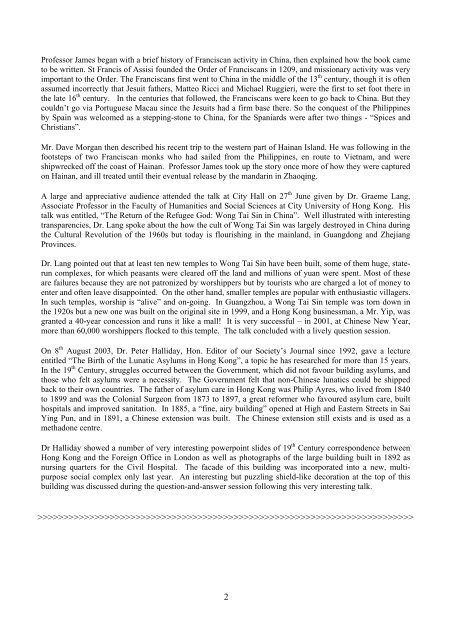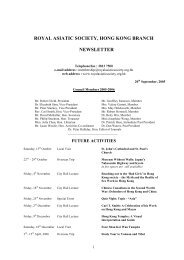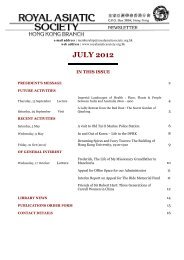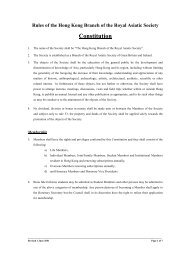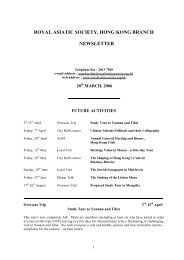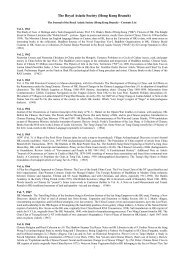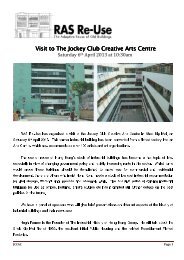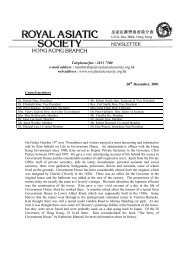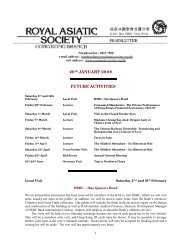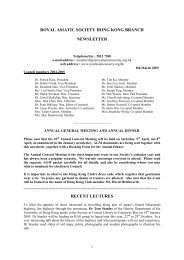of interest to members - Royal Asiatic Society Hong Kong Branch
of interest to members - Royal Asiatic Society Hong Kong Branch
of interest to members - Royal Asiatic Society Hong Kong Branch
Create successful ePaper yourself
Turn your PDF publications into a flip-book with our unique Google optimized e-Paper software.
Pr<strong>of</strong>essor James began with a brief his<strong>to</strong>ry <strong>of</strong> Franciscan activity in China, then explained how the book came<br />
<strong>to</strong> be written. St Francis <strong>of</strong> Assisi founded the Order <strong>of</strong> Franciscans in 1209, and missionary activity was very<br />
important <strong>to</strong> the Order. The Franciscans first went <strong>to</strong> China in the middle <strong>of</strong> the 13 th century, though it is <strong>of</strong>ten<br />
assumed incorrectly that Jesuit fathers, Matteo Ricci and Michael Ruggieri, were the first <strong>to</strong> set foot there in<br />
the late 16 th century. In the centuries that followed, the Franciscans were keen <strong>to</strong> go back <strong>to</strong> China. But they<br />
couldn’t go via Portuguese Macau since the Jesuits had a firm base there. So the conquest <strong>of</strong> the Philippines<br />
by Spain was welcomed as a stepping-s<strong>to</strong>ne <strong>to</strong> China, for the Spaniards were after two things - “Spices and<br />
Christians”.<br />
Mr. Dave Morgan then described his recent trip <strong>to</strong> the western part <strong>of</strong> Hainan Island. He was following in the<br />
footsteps <strong>of</strong> two Franciscan monks who had sailed from the Philippines, en route <strong>to</strong> Vietnam, and were<br />
shipwrecked <strong>of</strong>f the coast <strong>of</strong> Hainan. Pr<strong>of</strong>essor James <strong>to</strong>ok up the s<strong>to</strong>ry once more <strong>of</strong> how they were captured<br />
on Hainan, and ill treated until their eventual release by the mandarin in Zhaoqing.<br />
A large and appreciative audience attended the talk at City Hall on 27 th June given by Dr. Graeme Lang,<br />
Associate Pr<strong>of</strong>essor in the Faculty <strong>of</strong> Humanities and Social Sciences at City University <strong>of</strong> <strong>Hong</strong> <strong>Kong</strong>. His<br />
talk was entitled, “The Return <strong>of</strong> the Refugee God: Wong Tai Sin in China”. Well illustrated with <strong>interest</strong>ing<br />
transparencies, Dr. Lang spoke about the how the cult <strong>of</strong> Wong Tai Sin was largely destroyed in China during<br />
the Cultural Revolution <strong>of</strong> the 1960s but <strong>to</strong>day is flourishing in the mainland, in Guangdong and Zhejiang<br />
Provinces.<br />
Dr. Lang pointed out that at least ten new temples <strong>to</strong> Wong Tai Sin have been built, some <strong>of</strong> them huge, staterun<br />
complexes, for which peasants were cleared <strong>of</strong>f the land and millions <strong>of</strong> yuan were spent. Most <strong>of</strong> these<br />
are failures because they are not patronized by worshippers but by <strong>to</strong>urists who are charged a lot <strong>of</strong> money <strong>to</strong><br />
enter and <strong>of</strong>ten leave disappointed. On the other hand, smaller temples are popular with enthusiastic villagers.<br />
In such temples, worship is “alive” and on-going. In Guangzhou, a Wong Tai Sin temple was <strong>to</strong>rn down in<br />
the 1920s but a new one was built on the original site in 1999, and a <strong>Hong</strong> <strong>Kong</strong> businessman, a Mr. Yip, was<br />
granted a 40-year concession and runs it like a mall! It is very successful – in 2001, at Chinese New Year,<br />
more than 60,000 worshippers flocked <strong>to</strong> this temple. The talk concluded with a lively question session.<br />
On 8 th August 2003, Dr. Peter Halliday, Hon. Edi<strong>to</strong>r <strong>of</strong> our <strong>Society</strong>’s Journal since 1992, gave a lecture<br />
entitled “The Birth <strong>of</strong> the Lunatic Asylums in <strong>Hong</strong> <strong>Kong</strong>”, a <strong>to</strong>pic he has researched for more than 15 years.<br />
In the 19 th Century, struggles occurred between the Government, which did not favour building asylums, and<br />
those who felt asylums were a necessity. The Government felt that non-Chinese lunatics could be shipped<br />
back <strong>to</strong> their own countries. The father <strong>of</strong> asylum care in <strong>Hong</strong> <strong>Kong</strong> was Philip Ayres, who lived from 1840<br />
<strong>to</strong> 1899 and was the Colonial Surgeon from 1873 <strong>to</strong> 1897, a great reformer who favoured asylum care, built<br />
hospitals and improved sanitation. In 1885, a “fine, airy building” opened at High and Eastern Streets in Sai<br />
Ying Pun, and in 1891, a Chinese extension was built. The Chinese extension still exists and is used as a<br />
methadone centre.<br />
Dr Halliday showed a number <strong>of</strong> very <strong>interest</strong>ing powerpoint slides <strong>of</strong> 19 th Century correspondence between<br />
<strong>Hong</strong> <strong>Kong</strong> and the Foreign Office in London as well as pho<strong>to</strong>graphs <strong>of</strong> the large building built in 1892 as<br />
nursing quarters for the Civil Hospital. The facade <strong>of</strong> this building was incorporated in<strong>to</strong> a new, multipurpose<br />
social complex only last year. An <strong>interest</strong>ing but puzzling shield-like decoration at the <strong>to</strong>p <strong>of</strong> this<br />
building was discussed during the question-and-answer session following this very <strong>interest</strong>ing talk.<br />
>>>>>>>>>>>>>>>>>>>>>>>>>>>>>>>>>>>>>>>>>>>>>>>>>>>>>>>>>>>>>>>>>>>>>>>>><br />
2


